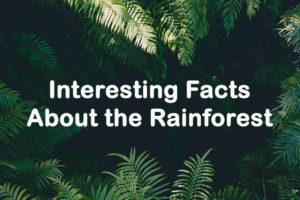Interesting Facts About the Rainforest

Rainforest
Rainforests cover 2% of the earth’s surface but are home to 50% of all species in the world! There are many endangered animal species that live in this ecosystem and their homes are being destroyed at a rapid rate. Not only does deforestation threaten wildlife, but it also affects climate change because trees absorb carbon dioxide which when they’re cut down releases it into the atmosphere.
Cutting down the enormous trees of the rainforest causes irreversible damage, which not only affects the animals who live in it, but also us! The animals provide us with things such as food and medicines. But deforestation not only threatens animals, it also threatens humans as well. As mentioned above, trees absorb carbon dioxide and without our forests’ help the air our planet would be polluted with harmful gas.
Rainforest is also a habitat for hundreds of plant species which are vital for animal survival. Each plant provides food to help sustain an animal’s life and these plants are destroyed when deforestation occurs. Evidence shows that many plants need animals to pollinate them because they have evolved to develop fruit that attracts them. So without these animals, these plants cannot reproduce and eventually will die off.
There are many species that are endangered due to deforestation and often they are forced into extinction. This is because of the destruction of their natural habitat, forest. For example, some species can only find refuge in the trees and when the trees are cut down they cannot survive in other areas where there isn’t much food available to them. When too many animals are affected by this process, it is very difficult for them to adapt because their habitat has completely changed around them and this causes certain animal populations to die off slowly over time or become extinct more quickly.
Rainforests are one of the most effective natural climate solutions
It may come as a surprise to many that rainforests actually play a very important part in fighting climate change. Yes, it’s true. Rainforests are one of the most powerful natural climate solutions. However, if we don’t take care of them now, they might go away and leave us with less than favorable results.
Why are rainforests such powerful natural climate solutions?
The rainforest absorbs and stores huge amounts of carbon dioxide each year. In fact, more than half of all this carbon dioxide is taken in by the trees. As the trees die, they bury themselves on the soil below and thus turn their carbon dioxide into sugars, which later on are broken down by microorganisms into pure carbon. This pure carbon is called humus and is basically vital to making up the organic matter in the soil. Organic matter holds a lot of water so it helps protect against water depletion and droughts in general. Rainforests also take care of rainfall patterns around them as well as help maintain an optimal temperature range necessary for plant growth and reproduction.
Rainforests are located in the equatorial zone, commonly known as the tropics. This entire region, on one side of the world or another, is warm and humid. In fact, in most areas throughout the year you won’t find any kind of dry season at all. All this has a very important effect on temperature range and rainfall patterns.
Rainforests produce their own rain
The warm and humid air works as a sort of blanket over the land and keeps the temperature up during cold nights and prevents excessive evaporation during hot days. This provides an ideal climate for plant growth throughout most of the year without any need to rely on rainy seasons for food production. This is why it has been said that rainforests produce their own rain.
Rainforests control rainfall patterns
The humid air in the tropics actually creates a zone of low pressure, or convergence, where moist air rises. This dense moist air travels higher and higher until it cools enough to release its moisture in the form of rain showers and lightning. It is this enormous amount of water vapor that causes such violent thunderstorms and heavy rainfall throughout much of the equatorial region. Without this convergence zone, these areas would have much less rain than they currently get.
Rainforests help to maintain moisture in the soil
The organic matter found in the top layer of the soil is called humus. All this humus serves as a sponge that soaks up water and keeps it locked away until needed for plant growth. Humus does not absorb all of its water at once but instead allows some to vaporize back into the atmosphere during very hot days or dry spells. However, there is always a reserve of water that is held captive inside this organic matter in case times get really dry and harsh and plants need more moisture than usual.
Rainforests help to regulate temperature range
All this humidity in the air creates a very effective blanket that helps keep temperature swings to a minimum. This is especially true where the temperatures are normally high because it has been shown that deforestation does in fact cause temperatures to rise significantly. In some areas, deforestation has caused average temperatures to rise as much as 3 degrees Celsius.
Rainforests help to prevent desertification and land erosion by holding soil and moisture in place
The organic matter found deep inside the top layer of soil is called humus. In order for plants to grow, they must first take root into some type of nutrient-rich soil or medium like sand, loam, or other material. Once the plant root has established a firm hold into this medium, it will start to draw in moisture from the soil and begin to grow leaves. The leaves produce food for the plant by converting sunlight into energy and giving off oxygen. All this organic activity in turn produces more humus which keeps the water content of the soil high enough to sustain growth.
Rainforests play a vital role in regulating global temperature, rainfall patterns, and groundwater resources while at the same time providing clean air and producing their own rain through evapotranspiration. In a nutshell, if it weren’t for rainforests we wouldn’t have very much fresh water left on earth or any kind of life that depends on freshwater.
Rainforests play an essential role in maintaining the Earth’s supply of freshwater
Rainforests are home to the largest reservoir of fresh water on Earth. There are five times as many trees in the Amazon rainforest (3 trillion) as there are people on Earth. And one tree can filter up to 90 gallons (350 liters) of water per day, according to experts. That’s more than a bathtub’s worth!
Are you thirsty for more?
In the rainforest, water is a precious commodity. It is held in trees and plants in the form of sap. The water cycle begins when the sun evaporates water. The water is then absorbed by plants through their roots. These plants give off moisture through their leaves and back into the air where it can evaporate again. In this way, water goes from being liquid to vapor and back again without ever touching soil.
If there were no rainforests, there would be less fresh water on Earth. And this vital resource would be fast disappearing with population growth and pollution.
Rainforests are thicker than you think
It can take anywhere from 10 minutes for a falling raindrop to make it all the way down from a rainforest’s thick canopy to its floor. This happens because of how trees in the forest are positioned, which causes water droplets to get caught in branches and leaves. For most of this time, water is bouncing up and down inside leaves, collecting organic material as it goes before making its way back onto branches again. After all this comes tumbling back out onto another leaf before getting caught on another branch and starting the process over again.
Amazon rainforest: The largest rainforest in the world
The Amazon rainforest is the largest rainforest in the world, as well as one of the most biodiverse habitats on Earth. Spanning across parts of Brazil, Bolivia, Colombia, Ecuador, French Guiana and Peru (the Amazon basin), this colossal forest is home to some three million species of plants and animals.
What makes it so special?
The Amazon region is the largest freshwater ecosystem in the world, and scientists believe that as many as one in ten plant species in the world may live there. The biodiversity of the trees in this tropical rainforest boasts an incredible amount of variety: approximately 18,000 different species. In comparison, North America’s famed Redwood forests have only 1300 species of trees – one-third of that.
All of this adds up to some pretty incredible numbers: it is estimated that 50-75 billion trees reside in the Amazon rainforest. That is a lot of trees! In fact, so many trees grow here that they are believed to store more carbon than anywhere else in the world. The Amazon basin stores about 20 billion tons of carbon, which is roughly 40% of all the carbon stored by forests in the entire world!
About 80% of life in the rainforest is found in the trees
The trees themselves house many different forms of life, and they give shelter to a diverse array of flora and fauna. And we are not talking about leaves and branches, but rather the spaces in between those structures that all too often go unnoticed.
That’s right — there is life in this seemingly empty void, like the hanging mosses that dangle from the edges of overhanging twigs. There are also all manner of parasitic vines, epiphytes such as bryophytes which thrive on top branches, a veritable world unto their own! These organisms are entirely reliant on their host tree for sustenance. They do not have roots of their own, but rather grow on the branches of trees with no apparent harm to either tree or plant.
Mosses and bryophytes are often so small as to be virtually undetectable to the human eye, which is why they are so easy to overlook. It is only when one looks at what seems to be a dead branch or twig that one realizes that there is much more going on than meets the eye. This is only the tip of the iceberg of life in a forest.
52% of the world’s animals live in rainforests
The rainforest is an amazing, hidden world of plants and animals. More than half of the world’s animals live in rainforests (52%). And there are around 18,000 different species that live in only one type of forest, such as vampire bats and anacondas who live in the South American rainforests. All the animals in the rainforest are adapted to live there. Many eat meat, some eat plants and some even eat other animals. The leopard is a predator, a meat-eater that hunts at night. The toucan has a beak that is very good at catching fruit.
Other animals can climb trees easily; things like monkeys can use their arms and tails to hang from branches. Animals such as sloths move slowly, spending most of their lives hanging upside-down from tree branches.
You can find more than 2000 species of butterflies are live in the Amazon Rainforest
Yes, its true, more than 2,000 species of butterflies live in the Amazon Rainforest. They come in a variety of shapes and colors, some have metallic sheens while others match the leaves they feed on. To find them, follow their butterfly sounds or lay on your back to watch for their silvery wings as they fly overhead. The insects also avoid detection by hovering from flower to flower, so spend plenty of time looking at forest flowers. While some butterflies are poisonous, most are harmless. One of the few insects that can protect itself from predators with a poisonous sting is the Brazilian emperor butterfly, found in the south-eastern part of Brazil.
Read more Facts and Knowledge

